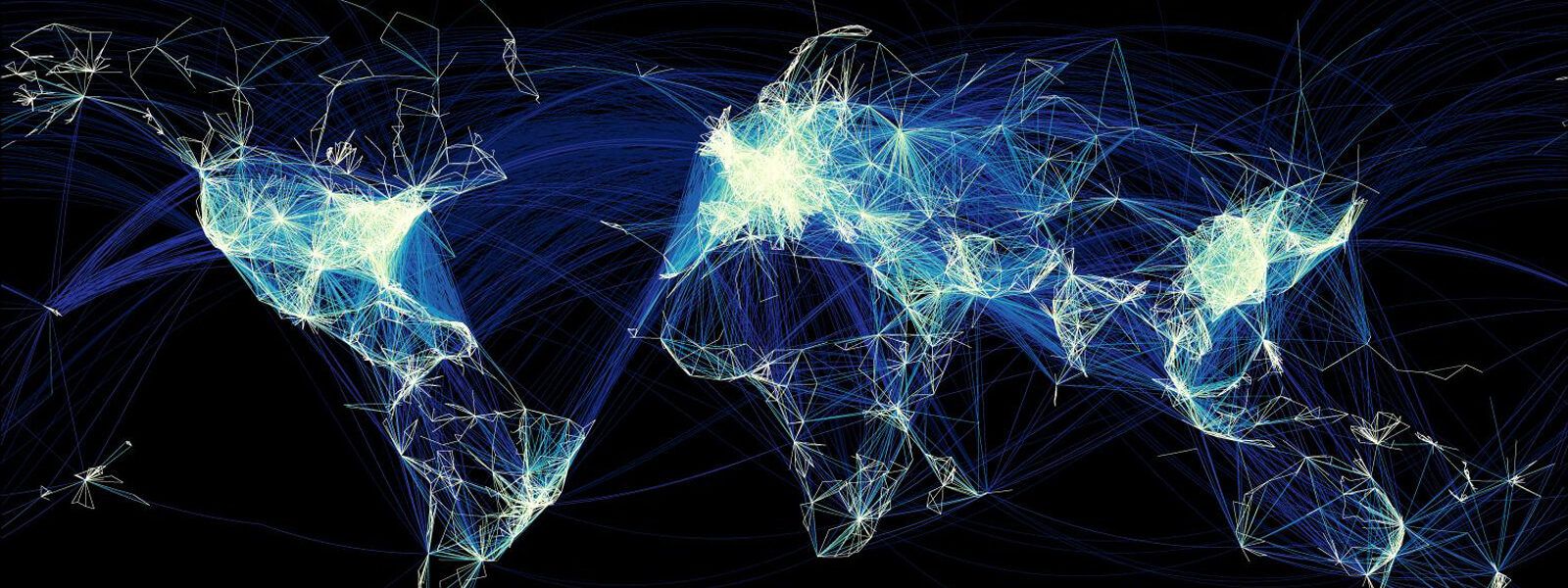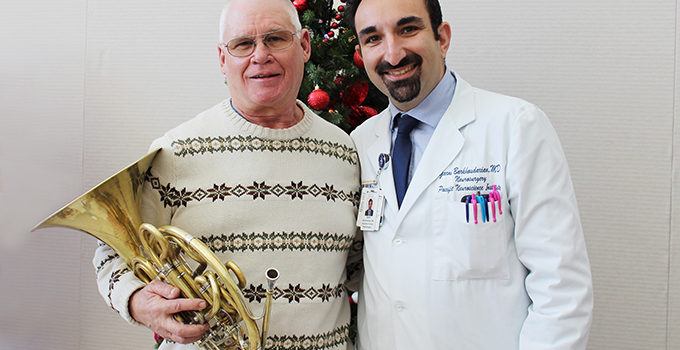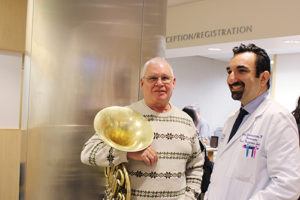

A New Beginning: Patient with Hemifacial Spasm Finds Relief after 30 Years
by Zara Jethani
The first time Chris experienced a spasm in the left side of his face it was 1988 and he was in his early thirties teaching music in the Fresno Unified School District in California’s Central Valley. Soft spoken and unassuming, he did not draw attention to it until it happened again. And again. And again.
A professional French horn player, Chris found that the hemifacial spasms began causing inconvenient and sometimes awkward episodes in his day-to-day life. He had trouble shaving or would worry when he was at a dental appointment. But most of all, the spasms took a toll on his playing and teaching. On one occasion he timed a spasm, which ended up lasting eighteen long minutes.
 His neurologist explained that in Chris’s case as in many other cases, the spasms were initiated by one of his facial nerves being pressed upon by a blood vessel causing constant irritation of the nerve and cascading into the resulting muscle spasm.
His neurologist explained that in Chris’s case as in many other cases, the spasms were initiated by one of his facial nerves being pressed upon by a blood vessel causing constant irritation of the nerve and cascading into the resulting muscle spasm.
After about 15 years of dealing with the hemifacial spasm, Chris began receiving Botox injections to help settle the face muscles. In many patients, this medical intervention helps to keep the spasms under control by desensitizing the muscles thereby making them less subject to nerve stimulation. Chris found relief with this first line treatment option but also experienced some side effects including double vision and longer lasting facial weakness. In addition, Botox treatment is not a permanent solution requiring repeated visits every four to six months.
Also as his facial muscles were stiffer, playing his beloved French horn, particularly the higher notes became increasingly challenging. Still, Chris continued his treatments until his retirement in early 2017.
A New Start

With a little more flexibility in his schedule, Chris asked his neurologist about the surgery that could help relieve his symptoms in a more long term and sustained manner. As no local surgeons had the experience of performing such a procedure, Chris was referred to Pacific Neuroscience Institute (PNI) and Garni Barkhoudarian, MD, in Santa Monica.
An expert neurosurgeon and Director of the Pacific Facial Pain Center at PNI, Dr. Barkhoudarian met Chris in February to discuss a microvascular decompression surgery (MVD). The high-resolution MRI performed, indeed identified a culprit blood vessel pulsating against the facial nerve. Dr. Barkhoudarian explained that the blood vessel pressing on the facial nerve would be lifted away using a minimally invasive endoscope-assisted surgical approach and a non-reactive soft teflon pad would be placed in between the nerve and vessel as a cushion to help stop the spasms. “In the ideal circumstance, MVD surgery should be performed within five years of the onset of symptoms for maximum success which is above 90 percent,” said Dr. Barkhoudarian. “Although Chris had been suffering with this condition for over thirty years and the timeframe was not optimal, his health was good and he was a great candidate for the surgery.“
“ My wife and I felt very comfortable as Dr. Barkhoudarian described the procedure.” Chris commented, “I knew I was in good hands especially when I found out that he is a violinist!”
Chris was confident in Dr. Barkhoudarian and had his surgery in April.
The Gift of Music

A successful surgery behind him, no more Botox injections and hardly any spasms at all now, Chris has been able to get back to what he loves, playing the French horn.
As his cheek muscles regain their strength and finesse, Chris is beginning to hit those higher registers with confidence. “I would not have done anything any differently,” he says. “I have my quality of life back and can do normal daily activities again.”
Just before Christmas he made a special trip to PNI to play for Dr. Barkhoudarian and staff members at the clinic. Chris then played a concert of Christmas music with his friend Ed on tuba at Providence Saint John’s Health Center for caregivers and visitors. “The doctors, nurses and staff at Providence Saint John’s and Pacific Neuroscience Institute have all been so wonderful,” he said, “this is my way of giving back.”


Zara Jethani, MS, MBA, is the marketing director for the Pacific Neuroscience Institute. Her background is in graphic design, molecular genetics research and healthcare marketing.
About the Author

Zara Jethani
Zara is the marketing director at Pacific Neuroscience Institute. Her background is in molecular genetics research and healthcare marketing. In addition, she is a graphic designer with more than 20 years experience in the healthcare, education and entertainment industries.
Last updated: January 11th, 2018